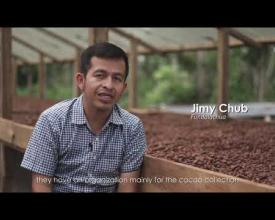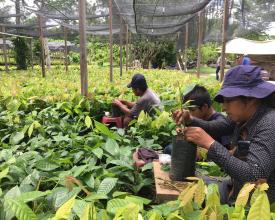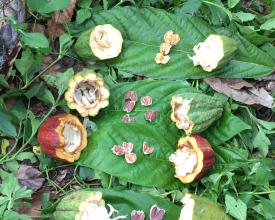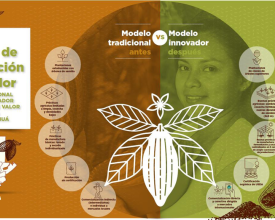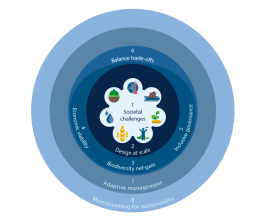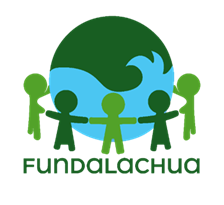
Agroforestry systems for sustainable cocoa farming in the Lachuá Ecoregion
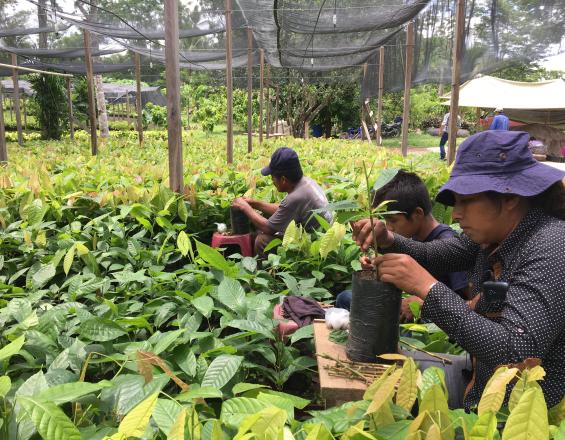
An estimated 30-40 per cent of annual household income in Guatemala is derived from forest products. Cocoa production was recognised as an economically viable alternative for job creation and increased local income, underscoring its economic, social, environmental and cultural value. As a native species typical of the region and high in yields and quality, cocoa had high potential to advance the economic and social development of producers and communities, particularly women and youth of the Q'eqchi' ethnic group. The intervention employed a Nature-based Solution in the Lachuá Ecoregion that supported 170 cocoa producers in an area of 303 ha and aimed to intensify cocoa production based on sustainable agroforestry management approaches that would not only contribute to local livelihoods, but also improve conservation and biodiversity outcomes through forest landscape restoration.
Contexto
Défis à relever
Poverty is a major challenge in the region and land-use changes have affected biodiversity and caused degradation. An assessment of livelihood options that provide economic, social and environmental benefits identified cocoa agroforestry systems as the most desirable option, also due to cocoa’s cultural value for Q'eqchi' Mayans. Cocoa was used as a form of currency and to prepare food and drink. Therefore, the main societal challenges addressed by the Nature-based Solution were economic and social development as well as environmental degradation and biodiversity loss. Through the intervention, income from cocoa agroforestry systems and access to international markets and value chains positively affected the livelihoods of producers.
Ubicación
Procesar
Resumen del proceso
The building blocks highlight a number of key insights that emerged from the assessment of the Agroforestry systems for sustainable cocoa farming intervention against the criteria and indicators of the IUCN Global Standard for Nature-based Solutionsᵀᴹ. While they do not give a full picture of what can be considered a Nature-based Solution as all criteria in the Global Standard are of equal importance, they illustrate some of the factors that made the project particularly successful. The lessons learned from experiences in the Lachuá Ecoregion resulted in a follow-up project with activities in a number of sites in Guatemala, involving 1,000 producers and achieving the restoration of 776 ha of land. In addition, the government defined a national goal of 15,000 ha of land to be dedicated to cocoa agroforestry systems.
Bloques de construcción
A robust business model considering the entire cocoa value chain
While the Nature-based Solution intervention focussed on changing land-uses towards good agricultural and manufacturing practices for cocoa agroforestry systems in the Lachuá Ecoregion, the project placed emphasis on developing strategies that cover the full cocoa value chain. This included production, processing, marketing, organisational capacities of local farmers and associations, support and involvement of technical assistance and services from key organisations as well as increased access to public and private funding mechanisms and investments. A financial and economic analysis was carried out as part of the project to develop a comprehensive business model for cocoa cultivation by community associations and Fundalachuá. The innovative business model relied on the creation of capacities and human capital for good agricultural and manufacturing practices, without large capital investments, infrastructure, equipment or supplies. Good governance and access to financing was ensured through producer associations, including first level organisations for storage and transport of products and second level organisations for marketing and technical assistance services to producers, including supporting the negotiation with international markets interested in high quality product.
Factores facilitadores
Besides the agricultural sector, tourism and private sectors were involved throughout the project to facilitate the mainstreaming of good practices into business models. Actions at local level ensured tailored approaches to local circumstances, while actions at national level contributed to the mainstreaming of organisational and technical capacities across the region. Further, the National Strategy for the Cocoa Agro-chain positioned the cocoa produced in the international market value chain.
Lección aprendida
The development of a robust and agreed business model in partnership with relevant actors, not only secured the sustainability of the intervention, but also created new opportunities to enter national and international markets. It promoted traditional productive activity in the region through a paradigm shift in the way crops are managed (pruning, fertilisation, shade, etc.) and in how added value is created (grain fermentation and quality management). Due to the improved quality of the cocoa, it was possible to increase the price from USD 2.28 to USD 4.50 per kg. The business model created at least 315 permanent jobs (an increase by 289 percent in comparison to the baseline) and increased the average daily income per capita by 342 percent. It served as a source of guidance on what, how and when to produce, how to sell the product and how to finance activities. Besides business plans for increasing market access for cocoa products, the project also supported the identification of other sources of income, including through tourism.
Long-term engagement and local knowledge to maximise biodiversity impact
A good understanding of the environmental, social and economic challenges was ensured through over 20 years of work in the region. This was substituted with a set of assessments using the Restoration Opportunities Assessment Methodology (ROAM) and the InVEST tool to provide evidence of direct and co-benefits. The analysis of the environmental and economic benefits of different land-uses was conducted and informed the choice of agroforestry options. Local and traditional knowledge from the local Indigenous Q'eqchi' community was particularly valuable in agreeing the limits of identified trade-offs. Additionally, a manual of good practices for cocoa cultivation was prepared to build capacities of the local community on sustainable cocoa agroforestry farming. The development of an agricultural calendar for cocoa cultivation in northern Guatemala contributed to increased accountability and transparency of production chain processes.
Factores facilitadores
Due to the longstanding presence of IUCN in the region, various studies on the status of ecosystems already existed. These served as a baseline to understand the positive outcomes for biodiversity of the NbS intervention. In addition, a key enabling condition for the NbS intervention was the formalisation of land tenure rights in the 1990s. The formalisation process involved local cocoa producers in the Lachuá Ecoregion.
Lección aprendida
The understanding and information generated through over 20 years of working in the region were key to identifying the relevant societal challenges and associated impacts on human wellbeing and proposing options acceptable in the specific social, economic and cultural context. Through the Nature-based Solution intervention, 303 hectares of monocrop areas were changed to cocoa agroforestry systems in areas of high value for conservation. Changes of land-use to agroforestry systems contributed to greenhouse gas emissions reductions of 9,320 tons of CO2e (1,864 tons of CO2e per year; 80 per cent increase in CO2e storage in terrestrial biomass, such as trees and roots, and 20 per cent in soils), erosion reduction between 33.8 and 107.7 tons per ha depending on land-use prior to cocoa agroforestry systems and sedimentation reduction between 0.03 to 4.6 tons per ha depending on land-use prior to cocoa agroforestry systems.
Ensuring social inclusion and involvement of indigenous women and youth
Throughout the project, consultations and participatory approaches and free, prior and informed consent (FPIC) were applied. In particular, local community associations were created and strengthened in close coordination with formal organisational structures (community councils for development). New employment opportunities were generated, especially for Q'eqchi' Maya youth and women, covering the value chain of production. An Institutional Technical Team was established at national level, which was responsible for coordinating and promoting actions in accordance with the National Strategy for the Cocoa Value Chain. The technical team involved the government of Guatemala, local NGOs and actors involved in the cocoa value chain. A total of 898 producers and technicians developed technical skills for sustainable agricultural and manufacturing practices (20 per cent women).
Factores facilitadores
As part of the intervention, producer associations for the collection, processing and transport of cocoa as well as the marketing and technical assistance services for producers were promoted. The established plantation management system and strengthened organisational and administrative capacities of associations and producers contributed to the success of the project.
Lección aprendida
The inclusion of traditional knowledge and involvement of Indigenous communities, and especially women and youth, increased equity and contributed to the success of the NbS intervention in terms of improved livelihoods and poverty reduction. Particularly young women and men profited and became recognised leaders, as they got involved in technical, managerial and administrative activities. In 2018, the initiative won the IUCN-Impact Award in the category of Social Inclusion, celebrating the engagement strategy of women and youth.
Impactos
The main positive impacts of the introduction of agroforestry systems for sustainable cocoa farming include the improvement of ecosystem services in previously degraded areas included soil retention, forest connectivity and carbon sequestration, among others. This had particular significance in the buffer zones of the Laguna Lachuá National Park and a Ramsar site. One of the key success factors of this intervention was the long-term support from IUCN and other initiatives, leading to good governance of local communities at several levels (e.g., the creation of Fundalachua, an IUCN Member, as a second level organisation). In addition, the close coordination with public programmes and investment as well as the reliance on good agricultural and manufacturing practices with a focus on building human capital and capacities, infrastructure, equipment or supplies, ensured sustainability over time. These elements allowed Fundalachua to lead the export of high quality cacao to several markets in South Korea and the USA among others. The intervention helped reduce poverty and strengthened livelihoods of local communities, mostly belonging to the Indigenous Q'eqchi' ethnic group. It contributed significantly to restoring degraded areas outside the protected areas (in the ecoregion) and reduced threats to the Laguna Lachuá National Park.
Beneficiarios
Q'eqchi' Maya ethnic group, 898 producers and technicians
Objetivos de Desarrollo Sostenible
Historia

Traditional cultivation of cardamom, low quality cocoa and mono-cropping practices of maize were commonplace in Guatemala. They were characterised by limited agricultural practices (clearing, harvesting and low densities), basic processing practices, individualised washing and drying, indirect, individual marketing through intermediaries and a lack of certification. Such traditional practices caused degradation, loss of soil health and negatively impacted biodiversity. The local government and local communities recognised that changes would be necessary to overcome poverty and accelerate social and economic development in the region. The idea of an innovative agroforestry system was born. It was important that such a system would not only promote sustainable practices, but also open new avenues for local communities to engage in the entire value chain from production to processing to accessing international markets.
The innovative cocoa agroforestry model agreed with local communities focusses on high quality trees, good agricultural practices (shade, pruning, harvesting, fertilisation, new planting densities), and good processing, fermentation and drying practices. The fact that producer associations now manage production and processing in centralised collection centres opened the doors for collaboration and logical links between the various steps in the value chain. Direct and collective marketing increased access to international markets and consequently increased local incomes. The award of the USDA Organic Certification testifies the quality and high value of cocoa products coming from Guatemala.
The greatest impact was seen in local communities, especially women of the Q'eqchi' ethnic group, who are the winners of the innovative agroforestry system for sustainable cocoa farming. In the words of cocoa producer Yasmina Chen Coc: "We had cocoa as something cultural, for consumption at home and to sell in small quantities. It seemed that cocoa was not important, but then we realized that cocoa brings us a lot, it brings me a lot when I sell my cocoa as slime, as beans and it also brings me a lot when I transform it into handmade chocolate. Sometimes we start talking with my husband and I tell him ‘have you noticed how our life has changed, when the cardamom production ends, the cocoa harvest comes, when the cocoa harvest ends, the corn harvest follows, so we always have our income.’"
